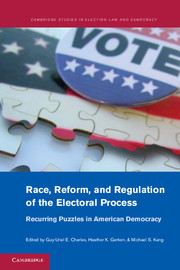Book contents
- Frontmatter
- Contents
- Figures
- Tables
- Contributors
- Preface
- Introduction: The Future of Elections Scholarship
- PART I RACE AND POLITICS
- PART II COURTS AND THE REGULATION OF THE ELECTORAL PROCESS
- PART III ELECTION PERFORMANCE AND REFORM
- Overview: Election Reform
- 8 New Directions in the Study of Voter Mobilization
- 9 Popular Election Monitoring
- 10 Democracy in the United States, 2020 and Beyond
- 11 Partisanship, Public Opinion, and Redistricting
- PART IV CONCLUSION
- Index
- References
11 - Partisanship, Public Opinion, and Redistricting
Published online by Cambridge University Press: 01 June 2011
- Frontmatter
- Contents
- Figures
- Tables
- Contributors
- Preface
- Introduction: The Future of Elections Scholarship
- PART I RACE AND POLITICS
- PART II COURTS AND THE REGULATION OF THE ELECTORAL PROCESS
- PART III ELECTION PERFORMANCE AND REFORM
- Overview: Election Reform
- 8 New Directions in the Study of Voter Mobilization
- 9 Popular Election Monitoring
- 10 Democracy in the United States, 2020 and Beyond
- 11 Partisanship, Public Opinion, and Redistricting
- PART IV CONCLUSION
- Index
- References
Summary
INTRODUCTION
When the Supreme Court first entered the political thicket with the “one person, one vote” cases of the 1960s, contemporaneous polls showed the Court to be on the right side of public opinion. In 1966, 76 percent of Americans called the Supreme Court decision “rul[ing] all Congressional Districts had to have an equal number of people in them so each person's vote would count equally” “right” (Louis Harris and Associates Poll, The Roper Center for Public Opinion Research). Few, if any, innovations from the Warren Court years met with such deep approval by the public or have had comparable staying power. Indeed, majorities continue to support redistricting based on population equality (see Ansolabehere and Persily 2009).
Beyond the easy-to-grasp concept of “one person, one vote,” however, the public has little knowledge or opinion concerning the redistricting process. Polling on redistricting has been done sporadically and locally. As a consequence, only a few published articles attempt to describe or account for public attitudes concerning the complicated and low salience modern controversies surrounding redistricting on such issues as partisan or incumbent protecting gerrymandering.
This chapter analyzes survey data with the hope of gauging where Americans stand on various controversies surrounding the redistricting process. The first part briefly presents the public opinion surveys utilized and the questions most central to the analysis. The second part begins by examining the extent to which the public is uninformed and lacks opinions about redistricting.
- Type
- Chapter
- Information
- Race, Reform, and Regulation of the Electoral ProcessRecurring Puzzles in American Democracy, pp. 227 - 260Publisher: Cambridge University PressPrint publication year: 2011
References
- 2
- Cited by



